Introduction
Agricultural operations are based on the traditional knowledge and experience of human beings. An appropriate solution to increase agricultural products is to increase yields per unit area. Now, in addition to increasing production, stability is also essential. Therefore, various farming systems and their production potential should be investigated and revised (Fateh, 2001). Fateh et al. (2013) explained that the biggest challenge in the next 50 years is to double food in ways that do not harm the environment and consumer health. Also, studies on agricultural systems are essential for understanding the developing factors and limiting factors. Today, the global approach is towards ecological agriculture, which is a sustainable agricultural branch. This farming system tries to avoid chemical origin supplies (Choghmaqi & Moradi, 2007). The conventional agricultural system in the use and management of resources has not achieved acceptable success because pesticides and fertilizers have led to the emergence of unsustainable farming ecosystems, environmental pollution, and quantitative and qualitative reduction of the product and energy efficiency.
Lotter et al. (2003), while studying the standard agricultural and biological systems, reported that absorption and storage of water of rainfall in plots with the biological system are 100% higher than in the standard method, which could improve gas exchanges and consequently performance. They also reported that the performance of the ecological system is 38 percent higher than the standard system. Jahan et al. (2009) reported that more nutritional elements, especially nitrogen, increase the water requirement proportionally to the plant's growth in the high-input system. They also stated that moisture is more available to the plant for transpiration in a low-input ecological agricultural system than in a high-input system. And the plant can maintain a higher temperature difference with ambient temperature through more transpiration. Higher soil capacity to retain moisture in ecological agricultural systems, especially biological systems, has been discussed in several sources (Lotter et al., 2003; Hole et al., 2005). Meanwhile, the existence of animal manure in the ecological agricultural system has exacerbated this issue.
Jahan et al. (2009) stated that a high-input system is superior in terms of traits such as seed yield, number of maize, and soil respiration. In terms of plant height, the difference between systems is not significant. The canopy temperature in the ecological system was approximately 10% lower than the high-input system. The differences between ecological and low-input systems are shallow, and at the same time, they are in the middle between input and moderate-input systems. In other words, a nearly 10% reduction in the performance of ecological and low-input systems is compensated not only by lower supplies in terms of costs but also for the stability of these systems in the long term. Oehl et al. (2004) reported that the consumption of fertilizers and energy in the biological farms decreases by 34-53 percent compared to the common ones. In contrast, the performance decrease of the biological method is only 20%.
What is essential in ecological systems is forming mutual effects for increasing the efficiency of material and energy consumption, self-sufficiency of reversibility, and sustainability over time. Economic performance in these systems among the high ecological values is not much attended (Gosling et al., 2006; Pimentel et al., 2005).
Materials and Methods
This research was conducted on a farm of Payam-e-Noor University, in Piranshahr, West Azerbaijan province, during 2014-2015 and 2015-2016 crop sessions. The experiment was conducted as a split-plot design with two factors and three replications. The first factor, which was considered the main plot, consisted of high-input, low-input, and ecological agricultural systems. Subplots were seed pre-treatment, including control (without priming), hydro priming (seeding in distilled water for 8 hours), and food priming with ascorbate (100 ppm ascorbic acid solution for 8 hours) (Harris et al., 2004). The wheat used is Azar 2 certified, which a semi-water cultivar was prepared from Oshnavieh Gold Cluster Company.
All crop operations, including plowing, pest, and weed control, were applied as registered in Table 1. The traits related to gas exchange, including photosynthesis, transpiration, sub-stomatal carbon dioxide, and mesophilic conduction, the activity of antioxidant enzymes, leaf chlorophyll content, ion leakage percentage, the relative water content of leaves, and protein content of the seed, were measured. The infrared gas analyzer (IRGA) model LCA4, manufactured by ADC Company of England, was used to measure photosynthesis per unit area of a leaf (μmol CO2 m-2s-1), transpiration rate (mmol m-2s-1), and CO2 sub-stomata concentration (μmol mol-1). All measurements were carried out at 10 to 12 hours in the light intensity of 1200-1400 micromoles photon per square meter per second. Before the measurement began, the device was turned on for 20 minutes. In each treatment, the middle part of the leaf under the flag of the main stem was placed in the glass chamber in eight stages, from flowering to the hard seed; and after one minute, the device data was recorded. Water use efficiency of photosynthesis (μmol CO2 mol-1) was also determined by dividing the photosynthesis rate per unit area of the leaf to transpiration (Siosemardeh et al., 2014).
Results and discussion
The variance analysis results showed that the effect of year on photosynthesis was significant at 5% level, and the impact of agricultural system and seed priming system was significant at 1% level (Table 2). As shown in Figure 1, the photosynthesis rate in the first year was approximately 12 μmol CO2 S-1, while in the second year, it decreased to 6.10. It should be noted that the precipitation in the second year was lower than in the first year. Also, comparing the agricultural system's average interactions showed no significant difference between the high-input and ecological agricultural systems regarding the photosynthesis of the wheat plant's flag leaf. In contrast, the lowest photosynthesis rate was associated with the low-input agricultural system (Fig. 2). The highest photosynthesis rate in the treatments was related to seed treatment with ascorbic acid. However, there was no statistically significant difference with hydro priming treatment, but there was a substantial difference with the control (Fig. 3).
Table 2 Analysis of variance of studied traits (AS=Agricultural system. P=priming, Y=Year)

* And ** There is a significant difference between them at the probability level of 5% and 1%, respectively.
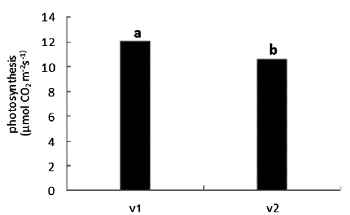
Figure 1 Comparison of the average effect of year: y1 (first year), y2 (second year) on the amount of photosynthesis of wheat.
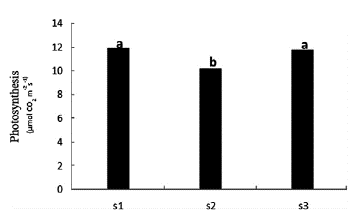
Figure 2 Comparison of the average effect of agronomic system: s1 (high-input), s2 (low-input) and s3 (ecological) on the amount of photosynthesis of wheat.

Figure 3 Comparison of the average effect of seed pre-treatment: pi (control), p2 (hydro priming) and p3 (ascorbic acid) on the photosynthesis of wheat.
This study's results are consistent with Fateh et al. (2013) on the positive effects of ascorbic acid priming on photosynthesis. Plants from primed seeds have expanded their root system compared to plants from untreated seeds during a shorter time. They reach the autotrophic stage with the better absorption of water and food and the production of photosynthetic green sectors. The realization of biological and ecological conditions gives a particular position to plants primed with seeds. These conditions allow the plant to use environmental elements, such as water and light, more appropriately. These cases' results can eventually lead to an increase in the photosynthetic rate and area in these plants.
Consequently, carbon dioxide stabilization and, naturally, the production of assimilates and the storage of non-structural hydrocarbons in different parts of the plant have increased. And as a result, higher biomass will be produced (Duman, 2006). The main effects of seed priming include seed germination, initial seedling establishment, increasing grain yield and biomass through increased photosynthesis due to faster plant establishment (Farooq et al., 2006; Harris et al., 2001; Duman, 2006).
Effect of year and agricultural system on transpiration rate was significant at 5% and 1% respectively (Table 2). As shown in Figure 4, the photosynthesis and transpiration rates were also higher in the first year than in the second year and, in the second year, the transpiration rate decreased by about 10% compared to the first year. However, unlike photosynthesis, transpiration rate was the lowest in ecological agricultural system (Fig. 5). The main factor in reducing the photosynthesis and transpiration rates under stress conditions is due to this strategy that, the plant uses the limited amount of water that it has to avoid drought and, it tries to close its stomata to prevent the water loss. With the onset of the dry period, the plant maintains its transpiration at maximum level for a while but, with the continuation of the dry period, it tries to narrow its stomata and eventually close those (Moradi et al., 2005).

Figure 4 Comparison of the average effect of year, yl (first year), y2 (second year) on the amount of transpiration rate of wheat.
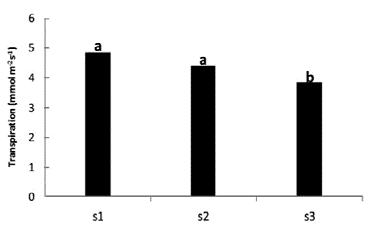
Figure 5 Comparison of the average effect of agronomic system: s1 (high-input), s2 (low-input) and s3 (ecological) on the amount of transpiration rate of wheat.
The effect of high-input, low-input and ecological systems at the level of 1% on the sub-stomatal carbon dioxide was significant (Table 2). The results showed that, under ecological conditions, the carbon dioxide content in the sub-stomatal cavity is less than that of the high-input system. Application of chemical fertilizers and chemical pesticides seems to cause stress in the plant and has increased carbon dioxide levels in the sub-stomatal cavity in the high-input system (Fig. 6). Fateh et al. (2011) reported that the sub-stomatal CO2 concentration under stress conditions was about 13% higher than the control condition. Under stress conditions, CO2 injected into leaves is not well used in photosynthesis. This suggests that any kind of stress action on the plant, in addition to closing the stomata and preventing the entry of CO2, also prevents the leaves from being processed by CO2 through the internal mechanism (Siosemarde et al., 2003). The reason for this is the effect of metabolic factors during stress on the reduction of carboxylation and the efficiency of carbon dioxide emissions into chloroplast and mesophilic cells. Under these conditions, it seems that non-stomatal limiting factors play an important role in reducing photosynthesis in drought stress. (Nazemosadat & Kazemini, 2008; Siosemarde et al., 2003).

Figure 6 Comparison of the average effect of agronomic system: si (high-input), s2 (low-input) and s3 (ecological) on sub-stomatal conductance rate of wheat.
Effects of crop year and system mesophilic conductivity was significant at i% level and seed priming effect at 5% level on (Table 2). As with the photosynthesis and transpiration rates, mesophilic conductivity was reduced in the second year. The decrease in mesophilic conductivity in the second year was about 14% compared to the first year, which was slightly higher than the decrease in transpiration (Fig. 7).

Figure 7 Comparison of the average effect of year: yl (first year), y2 (second year) on the mesophilic conductance of wheat.
Also, the mesophilic conductivity in the ecological agricultural system was higher than the low-input system however, there was no statistically significant difference with the high-input system (Fig. 8). In a study on durum wheat, in severe drought stress treatments, an increase in the concentration of sub-stomatal CO2 was associated with a significant decrease in mesophilic conduction and thus reduction of photosynthetic capacity of chloroplast. In this case carbon dioxide injected into the leaves has not been properly used in the photosynthesis process (Nazemosadat, & Kazemini, 2008). In addition, with the mean comparison between priming treatments in this study it was found that, as with other traits studied so far, applying seed food priming with ascorbic acid or vitamin C has led to increased mesophilic conductivity in wheat plants due to faster growth and better growth and more efficient use of resources than control treatments (Fig. 9).
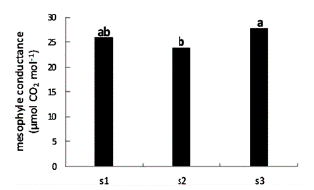
Figure 8 Comparison of the average effect of agronomic system: si (high-input), s2 (low-input) and s3 (ecological) on mesophilic conductance rate of wheat
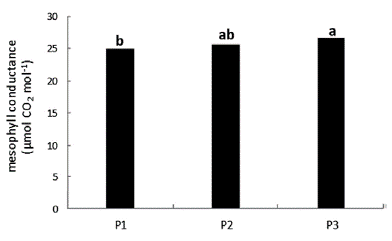
Figure 9 Comparison of the average effect of seed pre-treatment: pi (control), p2 (hydro priming) and p3 (ascorbic acid) on mesophilic conductance of wheat
The effect of agricultural system and also seed priming on the photosynthetic water use efficiency was significant at the level of 1%. Comparison of mean of treatments showed that in ecological agricultural system, photosynthetic water use efficiency was higher in comparison with low-input and high-input systems and, this difference is significant. The photosynthetic water use efficiency in the ecological system was 2.79 mmol/ mol/sec which was reduced by 12 and 7 percent, respectively, in high-input and low-input systems (Fig. 10). It was also determined that photosynthetic water use efficiency was higher in priming treatments (Fig. 11). Jahan et al. (2009) stated in their research that in general, in low-input and ecological agricultural systems, moisture available to the plant was higher than the high-input system for transpiration and the plant has been able to maintain a higher temperature difference with more transpiration. Several sources have referred to the greater soil capacity to maintain moisture in ecological agricultural systems, especially biological systems (Hole et al., 2005; Lotter et al., 2003), while the existence of animal manure in the ecological agricultural system has exacerbated this issue.

Figure 10 Comparison of the average effect of agronomic system: si (high-input), s2 (low-input) and s3 (ecological) on water use efficiency of photosynthesis of wheat.

Figure 11 Comparison of the average effect of seed pre-treatment: pi (control), p2 (hydro priming) and p3 (ascorbic acid) on water use efficiency of photosynthesis of wheat.
The interaction between the crop year and the agricultural system and also the effect of seed pre-treatment on wheat grain yield was significant at the level of 1% (Table 2). Comparison of the average of treatments using Duncan test at 5% probability level showed that in both the first and second year, the grain yield in the high-input system was higher than the other treatments. However, there was no significant difference between the low-input and ecological agricultural systems in both years (Fig. 12). The results also showed that seed priming with ascorbic acid in comparison with control increased the grain yield, and this increase was statistically significant (Fig. 13).

Figure 12 Comparison of the interaction effect of year: yl (first year), y2 (second year) and agronomic system, s1 (high-input), s2 (low-input) and s3 (ecological) on grain yield of wheat
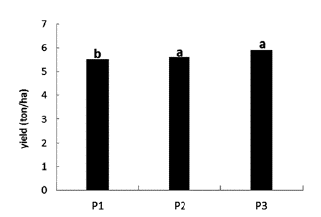
Figure 13 Comparison of the average effect of seed pre-treatment: p1 (control), p2 (hydro priming) and p3 (ascorbic acid) on grain yield of wheat
The photosynthesis rate did not differ in ecological and high-input farming systems. The highest photosynthesis rate and mesophilic conduction among treatments were seed priming treatment with ascorbate and hydro priming. Seed priming leads to accelerated germination and establishment of the green surface, and can eventually lead to an increase in the photosynthesis time and area (Duman, 2006). Under ecological system conditions, the intercellular CO2 concentration (Ci) was less than that of the high-input system conditions. It seems that the application of chemical fertilizers and chemical pesticides caused stress in the plant and increased the intercellular CO2 concentration (Ci) in the high-input system. Under stress conditions, CO2 injected into leaves is not well used in photosynthesis. In ecological farming system, the efficiency of photosynthetic water use was higher than the high and low input system. It was also determined that the relative water content of the leaf in the high-input system relative to the ecological system decreased by about 12%. It seems that in a low-input ecological farming system compared to high-input system, higher moisture has been available to the plant for transpiration and the plant could maintain higher temperature difference through more transpiration. Higher photosynthetic water use efficiency is due to more soil capacity to maintain moisture and also the presence of manure in ecological farming system. However, there was no significant difference between the two years in the low-input and ecological farming system. Common agriculture is based on maximum production. Agricultural sources such as water, soil and genetic diversity have been exploited excessively and are being destroyed. The only remaining choice is to preserve productivity of agricultural land for a long time along with the change in consumption pattern of inputs. Maintaining the long-term yield of agricultural land is a requirement for sustainable food production. This sustainability can be achieved through ecological processes on farms (Kohnaward et al., 2011). The ecological farming system, while protecting soil fertility, increases the production of the product without relying on the use of chemicals and achieving a stable production. Lower average yield in the long-term ecological system is possible through rising prices for these products. But the fact is that removal of chemicals is not enough to move from the common agricultural toward ecological farming (Kohnaward et al., 2011). During the transition period of the common systems to low-input systems, problems such as nutrient deficiencies and weed and pest problems are among the major factors affecting yield loss (Behdani et al., 2017).
Increasing yield in the common agricultural system is due to increased consumption of foreign inputs such as fertilizer, pesticide and herbicide. Generally, the yield of ecological system is less than the common systems for reasons such as lack of soil nutrients, stress of weeds, pests and diseases. Also, decreasing yields often occur during the transition period from common agriculture to ecological agriculture by removing chemical fertilizers, insecticides, fungicides and herbicides. Although the use of chemical fertilizers in high-input system may lead to a significant increase in yield in the short term, instead, the sustainability and stability of the yield of ecological systems over time will be higher due to the lack of chemical inputs. The ecological system is, in fact, a step towards the long-term and principled productivity of inputs and the prevention of the degradation and erosion of funds such as water and soil (Behdani et al., 2017).















